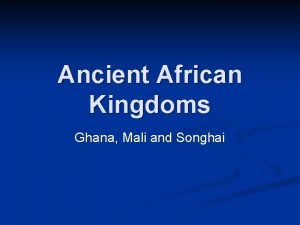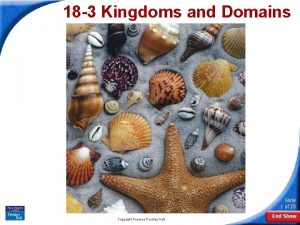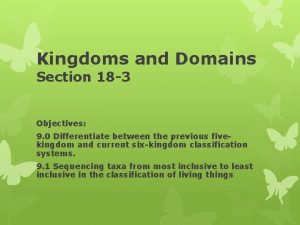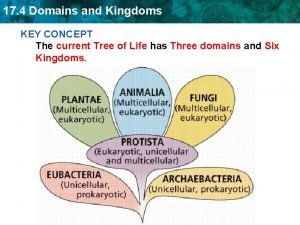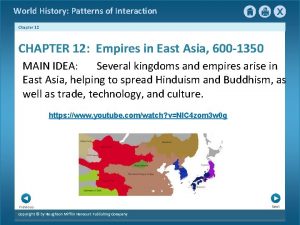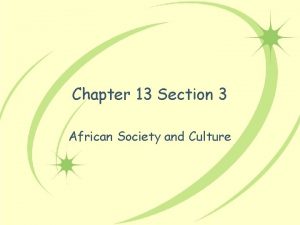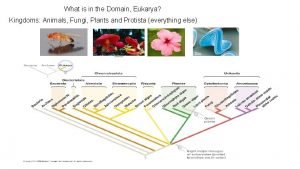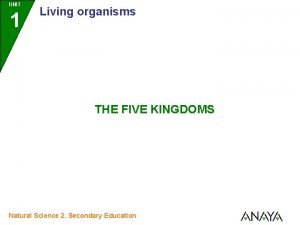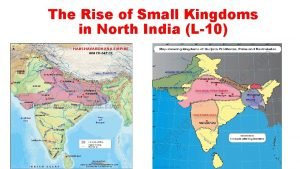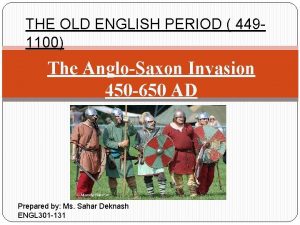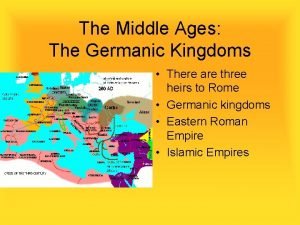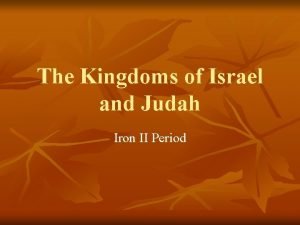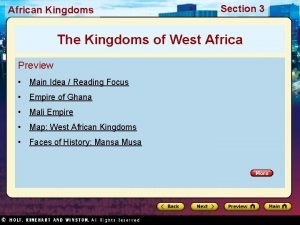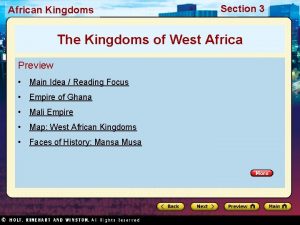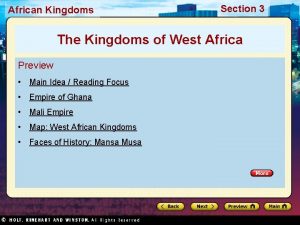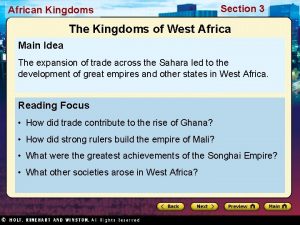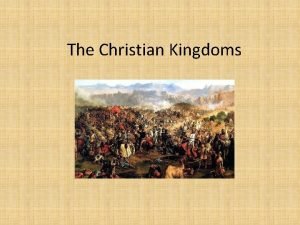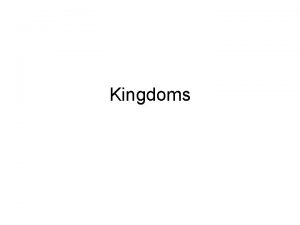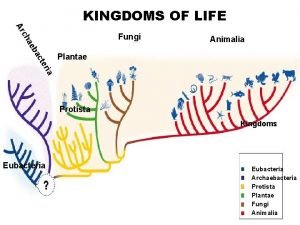African Kingdoms Section 1 African Kingdoms Section 1



















- Slides: 19

African Kingdoms Section 1

African Kingdoms Section 1 Early Civilizations in Africa Preview • Starting Points Map: Environments of Africa • Main Idea / Reading Focus • The Geography of Africa • Early African Societies • Africa’s Iron Age • Map: Bantu Migrations

Section 1 African Kingdoms Click the icon to play Listen to History audio. Click the icon below to connect to the Interactive Maps. • Arts and Literature

African Kingdoms Section 1 Early Civilizations in Africa Main Idea Africa’s earliest people adapted to a wide range of geographic conditions to establish societies based on family ties, religion, iron technology, and trade. Reading Focus • How does Africa’s diverse geography shape life on the continent? • What cultural patterns did Africa’s early societies share? • What major changes affected societies during Africa’s Iron Age?

Section 1 African Kingdoms The Geography of Africa’s large size—more than three times the size of the United States—and its location have led to a wide variety of climates and vegetation. As a result, distinct cultures and ways of life developed. Landforms • Continent has varied landscape • Plateaus cover much of central, southern interior • Low, wide plains across northern, western interior Valleys, Mountains • East, region of deep, steep-sided valleys, narrow lakes • Mountain ranges rim Africa, example Ethiopian Highlands in northeast Coastal Plains • Near coastline, land drops off to coastal plains • Some provide fertile farmland, others desert, swamp, sandy beaches

Section 1 African Kingdoms Climate and Vegetation • • • Africa’s climate also quite varied Northern Africa dominated by Sahara, largest desert in world Stretches 3, 000 miles between Atlantic Ocean, Red Sea Barren landscape includes mountains, plateaus, plains, sand dunes Temperatures in desert climb above 120°F, rain rare Number of oases scattered throughout desert, some support villages The Sahel • South of Sahara, mighty rivers flow across plains, including Congo, Zambezi, Niger • Region called the Sahel, strip of land dividing desert, wetter areas • Sahel fairly dry, but has vegetation to support hardy grazing animals The Savanna • Farther south, band of tropical savanna, open grassland • Extends east from Central Africa, wraps back toward south • Tall grasses, shrubs, trees grow there; variety of herd animals, majority of Africans live there

African Kingdoms Section 1 The Equator and farther South Tropical Rain Forests Southern Africa • Tropical rain forests found near equator and on Madagascar, island off southeast coast • Southern Africa consists mainly of hilly grasslands, deserts, high coastal strip of land • Hot, humid climate, yearround rainfall of rain forest supports broad range of plant, animal life • Region experiences mild Mediterranean climate, warm temperatures and both summer, winter rains

African Kingdoms Section 1 Adapting to Africa’s Environment Varied Climates • First people to live in Africa had to adapt to varied climates, features • Insufficient water supplies, poor soil in some places made farming difficult • Rainfall—too much, too little—presented problems that continue today Rains • Heavy rains erode soil, wash away nutrients important for growing crops • Insufficient rainfall leads to drought, poor grazing land • Farmers must decide which crops to grow based on expected rainfall Insects, Parasites • Parasites thrive in tropical areas; transmitted by mosquitoes to humans, animals; can lead to deadly diseases like malaria • Tsetse fly, sub-Saharan Africa, carries parasite than can kill livestock, infect humans with sleeping sickness, potentially fatal illness

Section 1 African Kingdoms Analyze What challenges can Africa’s environment pose to people living there? Answer(s): Insufficient water supplies, poor soil, and too much or too little rain cause problems for farmers; tropical parasites can spread disease.

Section 1 African Kingdoms Early African Societies Anthropologists think that the first humans lived in East Africa. Over thousands of years, people spread out over the continent, forming distinct cultures and societies. Early Farming Societies Pastoralists in Sahara • During early phase of their history, Africans lived as hunter-gatherers • First farmers likely pastoralists of Sahara—wetter 8, 000 years ago • About 9, 000 years ago, some began to grow native crops • 5, 000 years ago climate changed, Sahara became drier • In some parts, pastoralism, practice of raising herd animals, arose before farming • As land became desert, people migrated to Mediterranean coast, Nile Valley, parts of West Africa By about 2500 BC many people in these regions practiced herding and mixed farming.

Section 1 African Kingdoms Social Structures Common Features • Many societies developed village-based cultures • At heart, extended family living in one household • Families with common ancestors formed clans to which all members loyal Age-Sets • In some areas, people took part in type of group called age-sets • Men who had been born within same two, three years formed special bonds • Men in same age-set had duty to help each other Specific Duties • Loyalty to family, age-sets helped village members work together • Men hunted, farmed; women cared for children, farmed, did domestic chores • Even very old, very young had own tasks; elders often taught traditions to younger generations

Section 1 African Kingdoms Religion and Culture Many early Africans shared similar religious beliefs and shared common features in the arts as well. Examples of Beliefs Animism • Many believed that unseen spirits of ancestors stayed near • Many Africans also practiced form of religion called animism —belief that bodies of water, animals, trees, other natural objects have spirits • To honor spirits, families marked certain places as sacred places, put specially carved statues there • Families gathered to share news, food with ancestors, hoping spirits would protect them • Animism reflected Africans’ close ties to natural world

African Kingdoms Section 1 Griots • Many early societies did not develop systems of writing • Maintained sense of identity, continuity through oral traditions • Included stories, songs, poems, proverbs • Task of remembering, passing on entrusted to storytellers, griots Music and Dance • In many societies, music, dance central to many celebrations, rituals • Carving, wearing of elaborate masks part of these rituals as well • Early Africans excelled in sculpture, bronze as well as terra cotta • Traditional music performed with variety of wind, stringed instruments

Section 1 African Kingdoms Generalize What role did family ties play in early African culture? Answer(s): Families were the heart of village life. Each person was expected to be loyal to his extended family, and each member of a family had his or her own tasks.

Section 1 African Kingdoms Africa’s Iron Age The spread of iron technology after the 500 s BC changed farming practices in sub-Saharan Africa. As a result, African society changed. Iron Technology Population Growth • 500 BC, techniques for refining iron from iron ore changed • As better-equipped farmers, hunters, warriors, Nok grew in power • Now possible to produce tools, weapons superior to those they had made before • Nok one of earliest known peoples to practice ironworking • Lived in what is now Nigeria, West Africa; learned to make iron tools, weapons • Became known for making fine sculptures out of terra-cotta • Iron tools enabled Africans to cut down trees, clear land, and live in new areas • Survival easier, Africa’s population increased

African Kingdoms Section 1 The Bantu Migrations Agriculture, ironworking technology spread throughout Africa because of migration • Number of groups in Africa spoke related languages – Originated from language called Proto-Bantu – Developed in what is now Cameroon, Nigeria – Over time more than 2, 000 Bantu languages developed

Section 1 African Kingdoms Bantu-speaking Peoples Migration Bantu Social Systems • Bantu-speaking people gradually migrated east, south during first centuries AD • By AD 900 s, Bantu-speaking peoples had established complex social systems • As they traveled, Bantu speakers carried knowledge of agriculture, ironworking • Women farmed, men mostly tended cattle • Because of knowledge, established themselves as dominant group when they reached southern Africa • Cattle important food source, used in ritual sacrifices • Status in Bantu societies determined by size of cattle herds

African Kingdoms Section 1

Section 1 African Kingdoms Summarize How did African societies change with the spread of ironworking? Answer(s): Ironworking enabled Africans to live in places where they could not before the population grew.
 Powerful african kingdoms
Powerful african kingdoms West african kingdoms in order
West african kingdoms in order Pepidoglycan
Pepidoglycan Organizing lifes diversity
Organizing lifes diversity Section 18-3 kingdoms and domains
Section 18-3 kingdoms and domains Section 18-3 kingdoms and domains
Section 18-3 kingdoms and domains Kingdom protista concept map
Kingdom protista concept map Chapter 12 section 5 kingdoms of southeast asia and korea
Chapter 12 section 5 kingdoms of southeast asia and korea West african society and culture section 3
West african society and culture section 3 Domain eukarya
Domain eukarya Flow chart of domains and kingdoms
Flow chart of domains and kingdoms What are the five kingdoms of living things
What are the five kingdoms of living things Which kingdoms include only prokaryotes
Which kingdoms include only prokaryotes Dichotomous key for 6 kingdoms
Dichotomous key for 6 kingdoms Archaebacteria body type
Archaebacteria body type North indian kingdoms
North indian kingdoms Old england kingdoms
Old england kingdoms Germanic kingdoms
Germanic kingdoms Four kingdoms of spain
Four kingdoms of spain Kingdoms of israel and judah
Kingdoms of israel and judah

